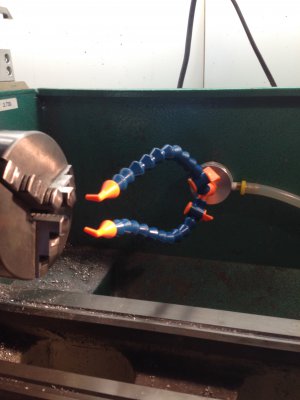- Joined
- Jan 22, 2014
- Messages
- 578
I would use a stubby screw machine drill to go as deep as possible using my dual-air blower to keep the chips cleared and minimize overheating. Then I would switch to a jobber drill to complete the hole if needed. Always best to keep the drill as short as possible and chips clear to prevent wandering.
Another trick I use on deep drilling to use my QCTP/compound to apply a very slight side load to the bit itself. to keep it running true.
I made a dual-nozzle chip air blower (w/regulator) to keep the 2 flutes cleared.

Another trick I use on deep drilling to use my QCTP/compound to apply a very slight side load to the bit itself. to keep it running true.
I made a dual-nozzle chip air blower (w/regulator) to keep the 2 flutes cleared.

Last edited:

